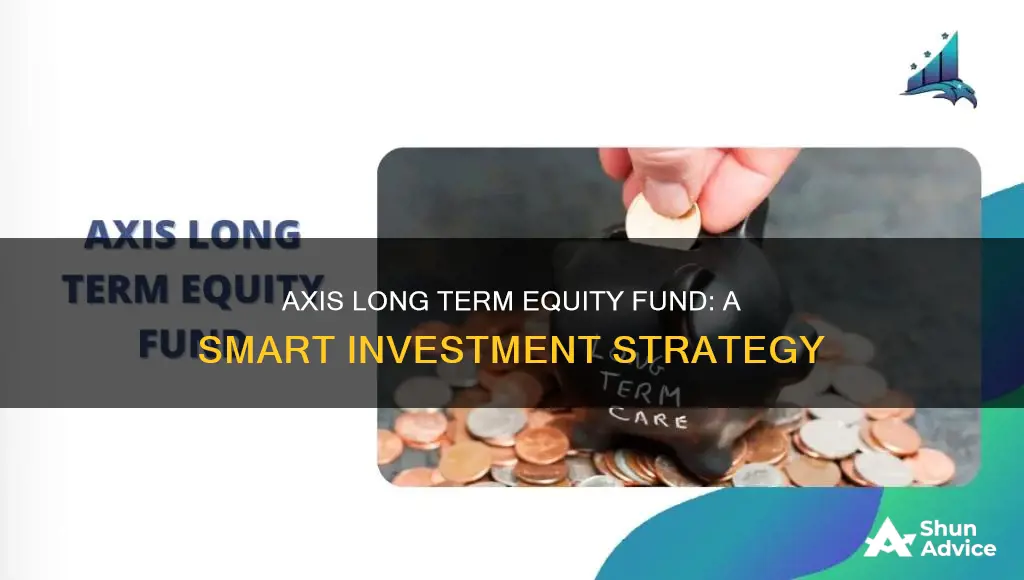
The Axis Long Term Equity Fund is an open-ended ELSS equity scheme that falls under the Axis Mutual Fund House. The fund was launched on December 29, 2009, and is managed by Shreyash Devalkar and Ashish Naik. The investment objective of the fund is to generate regular long-term capital growth from a diversified portfolio of equity and equity-related securities. The scheme will invest in companies with strong growth and a sustainable business model. The fund size is currently Rs. 38,422.94 Crore, with an expense ratio of 1.5% for the regular plan. The minimum investment required is Rs. 500, and the fund has a lock-in period of three years.
What You'll Learn

How to invest in Axis Long Term Equity Fund
The Axis Long Term Equity Fund is a mutual fund that aims to generate regular long-term capital growth from a diversified portfolio of equity and equity-related securities. The fund has a conservative investment strategy, with most of its holdings in Large Cap stocks and debt instruments. It offers tax benefits under Section 80C of the Indian Income Tax laws, providing tax exemption for investments of up to Rs 1.5 lakh in a financial year.
Step 1: Understanding the Fund
Before investing, it is essential to understand the nature and performance of the fund. The Axis Long Term Equity Fund has a very high risk, as per SEBI's Riskometer, and there is a lock-in period of three years. The fund has delivered returns of 15.17% since its inception 13 years ago. The latest Net Asset Value (NAV) and expense ratio are important factors to consider, as they impact the number of units you will receive and the fees associated with the investment.
Step 2: Choosing a Platform
You can invest in the Axis Long Term Equity Fund directly through the website of the fund house, Axis Mutual Fund. Alternatively, you can use platforms like MF Central or MF Utility. If you prefer not to invest online, you can seek the assistance of a mutual fund distributor, including most banks, which can guide you through the process.
Step 3: Investment Options
When investing in the Axis Long Term Equity Fund, you have the option to choose between a Regular Plan and a Direct Plan. The main difference lies in the expense ratio, which is higher for Regular Plans due to the commission paid to brokers/distributors. As a result, Direct Plans offer higher returns to investors.
Step 4: Placing the Order
Once you have decided on the platform and chosen your preferred investment plan, it is time to place your order. You can opt for a one-time investment or start a Systematic Investment Plan (SIP). Provide the necessary details, including the bank account from which you will make the payment, and confirm your investment.
Step 5: Tracking Performance
After investing in the Axis Long Term Equity Fund, it is important to monitor its performance. Keep track of the fund's NAV, which is declared daily, usually at the end of the day. Additionally, stay updated with the latest news and changes regarding the fund managers and their strategies.
By following these steps, you can invest in the Axis Long Term Equity Fund, taking into account your financial goals and risk appetite. Remember to consider the lock-in period and tax implications associated with this investment.
Best Vanguard Funds for Your Roth IRA
You may want to see also

The fund's performance and returns
The Axis Long Term Equity Fund has been underperforming for a while, mainly because the value investment strategy has been doing well in the market. Axis was known for its growth strategy. However, it is not wise to write off the growth strategy because of the rough patch in the last two years. It is likely to stage a comeback once the uncertainties that have been impacting the market sentiment.
The fund has delivered 34.06% returns in the last 1 year and since its launch in 2013, it has delivered 18.35% average annual returns. The fund has doubled the money invested in it every 4 years. The fund's ability to deliver returns consistently is lower than most funds in its category. Its ability to control losses in a falling market is low.
The fund's portfolio is largely conservative, with most holdings in Large Cap stocks and debt instruments. The fund has a very high risk level.
Diversify Your Portfolio: Avoid Single Mutual Fund Investments
You may want to see also

The fund's portfolio and asset allocation
The Axis Long Term Equity Fund, previously called the Axis ELSS Tax Saver Direct Plan-Growth, is an open-ended ELSS equity scheme. The fund's portfolio is largely conservative, with a focus on large-cap stocks and debt instruments. As of 30-Sep-2023, the asset allocation of the fund was as follows: 98.33% in equity, 1.56% in debt, and 0.12% in cash and cash equivalents. The fund has a very high risk level according to SEBI's Riskometer.
The fund's top holdings include companies such as Torrent Power Ltd., Tata Consultancy Services Ltd., Bajaj Finance Ltd., and Avenue Supermarts Ltd. The fund's performance has been mixed, with returns of 34.06% in the last year and average annual returns of 18.35% since its inception in 2013. The fund's ability to deliver consistent returns is lower than most funds in its category, and its ability to control losses in a falling market is low.
The expense ratio of the fund is 1.5%, and there is no exit load. The minimum investment required is Rs 500, and the minimum additional investment is also Rs 500. The fund size is Rs 38,422.94 Cr as of Aug 31, 2024.
Choosing a Fund: Key Factors for Smart Investing
You may want to see also

Taxation and exit load
Taxation
Investments of up to Rs 1.5 lakh in a financial year in eligible securities such as the Axis Long Term Equity Fund are exempt from tax under Section 80C of the Indian Income Tax laws.
If you sell mutual fund units after 1 year from the date of investment, gains up to Rs 1 lakh in a financial year are exempt from tax. Gains over Rs 1 lakh are taxed at a rate of 10% (Long-term Capital Gain Tax). If you sell within 1 year, the entire amount of gain is taxed at a rate of 15%. Dividends are added to the income of investors and taxed according to their respective tax slabs. If an investor's dividend income exceeds Rs. 5,000 in a financial year, the fund house also deducts a TDS of 10% before distributing the dividend.
Exit Load
The Axis Long Term Equity Fund does not attract any exit load.
Money Market Funds: Investment Options and Strategies
You may want to see also

The fund's risk rating
The Axis Long Term Equity Fund has a risk rating of "very high" according to SEBI's Riskometer. This means that while the fund offers the potential for significant returns, there is also a substantial risk of losing money.
The fund's performance has been mixed, with a rating of "poor" on the Outperformance Consistency metric. This indicates that the fund has not consistently generated high returns relative to other funds in its category.
The fund's portfolio is considered conservative, with most holdings in Large Cap stocks and debt instruments. This investment strategy aims to balance risk and return by investing in well-established companies while also allocating a portion to fixed-income securities.
The fund has delivered annualised returns of 16.6% over a 14-year period, as of July 2024. However, it is important to note that past performance does not guarantee future results, and mutual funds are subject to market risk.
When investing in this fund, it is crucial to have a long-term investment horizon. The fund manager recommends a minimum investment period of 5-7 years due to the potential for short-term volatility. Additionally, there is a lock-in period of three years, meaning you cannot withdraw your money from the fund before completing three years from the date of investment.
In terms of taxation, the Axis Long Term Equity Fund offers tax benefits under Section 80C of the Indian income tax laws. Investments of up to Rs 1.5 lakh in a financial year in this fund are exempt from tax. However, capital gains tax will apply if you sell your investments after three years, with a current tax rate of 10% for long-term capital gains exceeding Rs 1 lakh in a financial year.
Overall, the Axis Long Term Equity Fund presents a high-risk investment opportunity with the potential for substantial returns. It is essential to carefully consider your investment goals, risk tolerance, and time horizon before deciding to invest in this fund.
Vanguard Index Fund: When to Invest for Maximum Returns
You may want to see also
Frequently asked questions
You can buy mutual funds directly from the website of the fund house. For instance, the Axis Long Term Equity Fund can be purchased from the website of Axis Mutual Fund. You can also buy mutual funds through platforms like MF Central and MF Utility. If you are not comfortable buying mutual funds online, you can seek help from a mutual fund distributor. Most banks also act as mutual fund distributors.
The NAV of the Axis Long Term Equity Fund was ₹70.6517 as of 01-Nov-2023.
The AUM of the Axis Long Term Equity Fund was ₹31,887 Cr as of 30-Sep-2023.







